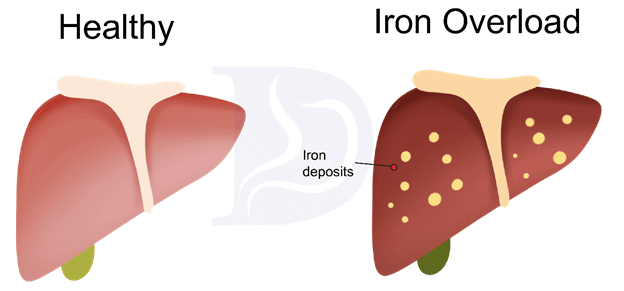Hemochromatosis is a condition resulting from excessive iron build-up in the body. Serious illness can arise because the body is unable to excrete this excess iron. Excessive iron build-up can occur in the liver, skin, heart, pancreas, joints, heart, and pituitary gland. Deposits of unwanted iron in the organs can cause tissue and organ damage.1
Hemochromatosis is caused by an inheritable gene, but only a minority of people will develop severe disease. Normally, the small intestine absorbs the required amount of iron, and excessive iron is excreted. However, in hemochromatosis, intestinal absorption exceeds the excretion2.

Causes of Hemochromatosis
The exact cause of hemochromatosis is unknown. However, an inherited gene is responsible for the disease. The gene responsible for the disease is common, but the chances of getting the disease are low. Studies show that the disease occurs when a child inherits the gene from both parents. In some cases, gene mutations can also cause hemochromatosis.3
Symptoms
The disease can occur at any stage, but symptoms usually arise in middle age. Women show signs earlier than men typically do. Signs and symptoms will vary depending upon the organ in which the excess iron is stored.4
- Liver: The liver is the primary target of hemochromatosis because it plays a role in iron metabolism and storage. When the liver is damaged, scarring and hardening occur, which leads to cirrhosis. This may also lead to jaundice and other liver-associated illness.
- Hemochromatosis can also damage the heart, pancreas, and skeletal system.
The following signs are commonly present with hemochromatosis:
- Weakness and fatigue
- Weight loss
- Low sex drive and erectile dysfunction
- Greyish to blackening of the skin
- Abdominal pain
- Joint pain
- Brain fog
- Liver and heart failure in chronic conditions.5
Diagnosis
Early diagnosis is important to prevent long-term effects and irreparable damage. Family history and the symptoms present will dictate the need for further tests, including:
Blood tests
A blood test can determine the level of iron in the blood. Moreover, a blood test is also performed to check the amount of ferritin in the blood, which is an iron-carrying protein. If the level of iron and ferritin are high for multiple tests over a period of time, then there is a good possibility of hemochromatosis occurring.
Genetic testing
A DNA test can help identify the gene responsible for this disease. The HFE gene present on chromosome 6 is responsible for iron storage. Two common mutations, C28Y and H63D, lead to hemochromatosis.
Liver biopsy
The liver is the primary organ responsible for iron storage. Therefore, the liver is the first organ affected when excessive iron storage occurs. A doctor can perform a liver biopsy by removing a small amount of tissue from the liver and testing it for excessive presence of iron.
MRI
Scanning through MRI is a noninvasive technique used to detect abnormal iron storage in various organs.
Treatment
Treatment is available to manage hemochromatosis.
Phlebotomy
With phlebotomy, blood and iron are taken from the patient. A needle is inserted into a vein to draw out blood, similar to blood donation. This procedure reduces the level of iron in the blood.
Chelation
One alternative to phlebotomy is chelation, in which a doctor may prescribe pills or injections that will help expel excessive iron from the body through urine and stool. This is a costly treatment and is prescribed only for patients suffering from heart disease with a critical need to reduce iron levels.
Liver transplant
If cirrhosis of the liver is severe, and the condition is irreversible, a physician may prescribe a liver transplant, which is the most extreme solution to hemochromatosis in the liver.
Summary
Hemochromatosis is a condition of iron toxicity in the body. It may damage multiple organs, including the liver, spleen, joints, heart, and pituitary gland. Early diagnosis of hemochromatosis plays an important role in the prognosis of the disease.
References
- Porter JL, Rawla P. Hemochromatosis. Med Interna Mex. 2021;35(6):896-905. doi:10.24245/mim.v35i6.2693
- Ponka P. Rare causes of hereditary iron overload. Semin Hematol. 2002;39(4):249-262. doi:10.1053/shem.2002.35638
- Geller SA, Campos FPF de. Hereditary hemochromatosis. Autops Case Reports. 2015;5(1):7. doi:10.4322/ACR.2014.043
- Golfeyz S, Lewis S, Weisberg IS. Hemochromatosis: pathophysiology, evaluation, and management of hepatic iron overload with a focus on MRI. Expert Rev Gastroenterol Hepatol. 2018;12(8):767-778. doi:10.1080/17474124.2018.1496016
- Bacon BR, Adams PC, Kowdley K V., Powell LW, Tavill AS. Diagnosis and Management of Hemochromatosis: 2011 Practice Guideline by the American Association for the Study of Liver Diseases. Hepatology. 2011;54(1):328. doi:10.1002/HEP.24330

